Do you have a Pinterest business account? If not, I get it—Pinterest isn’t typically the first platform eCommerce brands think of when it comes to driving profits. While it’s true that not every brand is a natural fit for Pinterest, those that are can see incredible results with the right ad strategy. That’s why I’ve put together this list of Pinterest ad tips.
Pinterest thrives on inspiration. In simple terms, your product needs to be visually appealing to succeed here. This is why industries like fashion, beauty, and interior design tend to perform exceptionally well. However, that doesn’t mean other niches can’t succeed. The key is to tap into your creativity and make your brand stand out.
So, let’s dive into 21 proven Pinterest ad strategies to help you crush your first—or your hundredth—campaign. With over $800K in Pinterest ad spend under our belt, we’ve learned what works and what doesn’t.
What is Pinterest?
Pinterest is a visual discovery engine where users create image boards to explore their interests. From recipes to home decor, fashion, and beyond, Pinterest offers endless ideas and inspiration. Users save “Pins” they like to their boards, making it easy to revisit and act on them later. For entrepreneurs exploring creative ways to grow their brands, platforms like Pinterest can be invaluable, whether you’re looking for guidance on how to start a t shirt business or aiming to showcase your products effectively.
Many consumers turn to Pinterest when seeking inspiration or researching options before making a purchase. For brands, this is a golden opportunity—most users are already in a buying mindset and are simply looking for the right product or service. That’s where your brand can shine.
Adding Pinterest to your social media strategy is a smart move, especially since the competition is relatively low. Only about 1.5 million brands actively use Pinterest to reach users each month, compared to 3 million on Facebook. This means more opportunities and less crowded ad space for your business.
In this guide, we’ll walk you through everything you need to successfully incorporate Pinterest into your marketing strategy. From understanding the platform to mastering Pinterest ads, we’ll cover the essentials and share expert tips to help you get the most out of your campaigns.
Why advertise on Pinterest?
Pinterest is more than just a social image-sharing platform—it’s a powerful tool for growing your business. With Pinterest, you can boost brand awareness, drive website traffic, and generate leads and sales.
How does Pinterest accomplish this? It’s simple.
When a user sees your ad in their Pinterest feed, they’re often already in a purchasing mindset. They’re using Pinterest to explore ideas and find inspiration. By offering a Pin with a clear, easy-to-click link, you not only drive traffic to your website but also increase the likelihood of a sale, since the user is actively considering a purchase.
Even if they don’t buy immediately, seeing your Pin during their search for inspiration builds brand awareness. Your product or service stays top of mind, making it more likely they’ll return and convert into a customer when they’re ready to buy.

But don’t just take our word for it. There are numbers to back up the success of Pinterest ads. Pinterest drives 3.8x greater sales than the average digital campaign. Even more impressive than this, 83% of weekly users have made a purchase based on content they saw on their Pinterest feeds. And 84% of pinners use the site to decide what to buy.
Here are some more facts about Pinterest ads:
- 50% of users have made a purchase after seeing a Promoted Pin (Pinterest ad)
- 64% of users describe Pinterest as a place to find ideas, products or service they can trust
- 77% of weekly users have discovered a new brand or product on Pinterest
- 98% of users said they try new things that they find on Pinterest
Pinterest is undoubtedly a powerful tool that every marketer should leverage. But how do you get started with advertising on Pinterest? The first step is creating a business profile—and that’s exactly what we’ll dive into next.
How to Launch Pinterest Ads?
Much like Instagram and Facebook, creating a Business Profile on Pinterest unlocks the ability to run advertisements and track analytics. If you already have a personal Pinterest account, you can link your new business profile to it, making it easy to switch between the two.
Got multiple side businesses? Pinterest has you covered—you can add up to four business profiles to a single personal account. Prefer to keep personal and business separate? No problem. You can always create a standalone business account.
Follow these simple steps to set up your Pinterest Business Profile and launch your first ad.
1. Create your account
If you already have a personal Pinterest account, you can create a business account directly while logged in. However, if you’d prefer to keep your personal and business accounts separate, log out of your personal account before proceeding.
To get started, visit the Pinterest website. In the top-right corner, click the “Sign up” button. A form will appear, and just below it, you’ll see an option to “Create a business account.” Be sure to select this option before entering your details.

You can also create your profile using your Facebook or Google account—just choose the option that works best for your business.
If you’re logged into your personal account, setting up a business profile is easy. Simply go to your Pinterest homepage, click the down arrow in the top-right corner to open the menu, and select “Add a free business account.”
2. Set up your profile
The next step is setting up your profile information. Pinterest will prompt you to enter details such as your business name, website, country, and language. You’ll also need to upload a profile picture to help users easily recognize your brand.
Next, you’ll select multiple classifiers for your business, including its focus, type, and whether you’re interested in running ads (which, of course, is why we’re here!). Once you’ve completed all the prompts, voilà—your Pinterest Business Profile is ready to go! ✨
3. Create an ad with Pinterest Ads Manager
Pinterest makes advertising simple with its dedicated ad platform, Pinterest Ads Manager. This tool allows you to create campaigns, set goals, and manage your budgets with ease.
To get started, visit the Pinterest Ads page. In the top-left corner, click on the “Ads” tab to open a drop-down menu. From there, select “Create ad” to begin building your campaign.
4. Choose a campaign goal
Choose the main goal of your ad campaign. Do you want to build brand awareness? Drive traffic? Increase sales? Whichever your business’ priority is, you can set it up in this step.
5. Ad group details
Your Promoted Pins are grouped together into ad groups. In this step, name your ad group based on it’s focus (e.g. Clean skincare).
6. Choose your target
Next, you’ll choose who you think is most likely to be interested in your ads through targeting. You’ll be able to enter details for audiences, keywords, interests, and demographics. There are other tools available as well, such as choosing the placements of your ads on the Pinterest ads platform.
7. Budget and Schedule
The next step is to set up your campaign’s budget and schedule.
For scheduling, you’ll select a start date. While adding an end date is optional, Pinterest recommends running campaigns continuously and reserving end dates for seasonal or time-sensitive promotions.
When it comes to your budget, you can choose between a lifetime budget or a daily budget. Pinterest typically suggests focusing on a daily budget for better control and flexibility.
8. Start Pinning!
If you already have Pins on your business profile, you can choose to promote the ones that are performing well. Alternatively, you can create a new Pin and promote that instead. As a best practice, always link each Promoted Pin to your website, making it easy for interested consumers to learn more with just one click.
9. Use Analytics
In the Pinterest Ads Manager dashboard, you can view detailed analytics for your ad campaigns. Track key metrics like traffic, views, conversions, and more with Pinterest’s built-in reports. Use these insights to assess your ads’ performance and optimize future campaigns for even better results.
Different types of Pinterest Ads
Pinterest offers a range of ad formats to suit different campaign goals. Here’s a quick overview of the 5 types of Pinterest Ads you can use.
Pinterest Ad #1: Standard Pins
The standard Pin is the simplest and most popular ad format on Pinterest. If you choose a standard Pin ad, be sure to include a vertical image that’s visually striking enough to capture users’ attention as they scroll through their feed.

Pinterest Ad #2: Video Pins
This ad format is similar to the standard Pin, but instead of a single image, you can use a video. You can also add a title and description to your video. When using video Pins, ensure the first few seconds are captivating and engaging to grab viewers’ attention!
Pinterest Ad #3: Product Pins
A Product Pin is an excellent way to boost sales. It simplifies shopping for Pinterest users by displaying an image, price, and availability of the product.

Clicking on a Product Pin will take the user to your website or store, where they can learn more and, hopefully, make a purchase!
Pinterest Ad #4: Collections
This ad format lets you showcase multiple products in a single Pin. In the example below, the main image features a man wearing a stylish outfit, with a collection of images beneath showing each item he’s wearing. This format is effective because it allows users to see how the items work together and click on each one individually for more details.

Pinterest Ad #5: Story Pins
Story Pins is a new ad format introduced by Pinterest. It uses multiple images to tell a story for your business. You’ll select a cover image to give users a preview of the story, then choose at least three images that users can swipe through.
Pinterest ads tips
Pinterest ads can be a powerful tool to boost brand awareness, drive traffic, and increase sales. With its unique visual focus and intent-driven audience, Pinterest offers a great opportunity for marketers to reach consumers actively seeking inspiration and ideas.
In this guide, we’ll share essential Pinterest ads tips to help you create effective campaigns that stand out, connect with your target audience, and deliver real results. Let’s dive in!
1. Audience Segmentation
One of the first things we discuss with clients is the audience: Who are we targeting? We recommend taking the time to find the right audience for your brand. As a general rule of thumb, it’s better to aim for a slightly broader audience than you’re comfortable with. For example, if you think your target is 18-34-year-old women, consider expanding it to 18-54-year-old women. Being too precise isn’t the best approach for Pinterest ads.
For segmentation, you can choose from:
- Interests
- Keywords
- Demographics (age, gender)
- Behaviors (e.g., online shoppers)
- Geographical targets
- Personalized audiences (lookalikes and custom audiences)
The key question is: What should you focus on in your Pinterest ads targeting? Always include geographic and demographic targeting, along with one or more of the following: interests, keywords, behaviors, or personalized audiences.
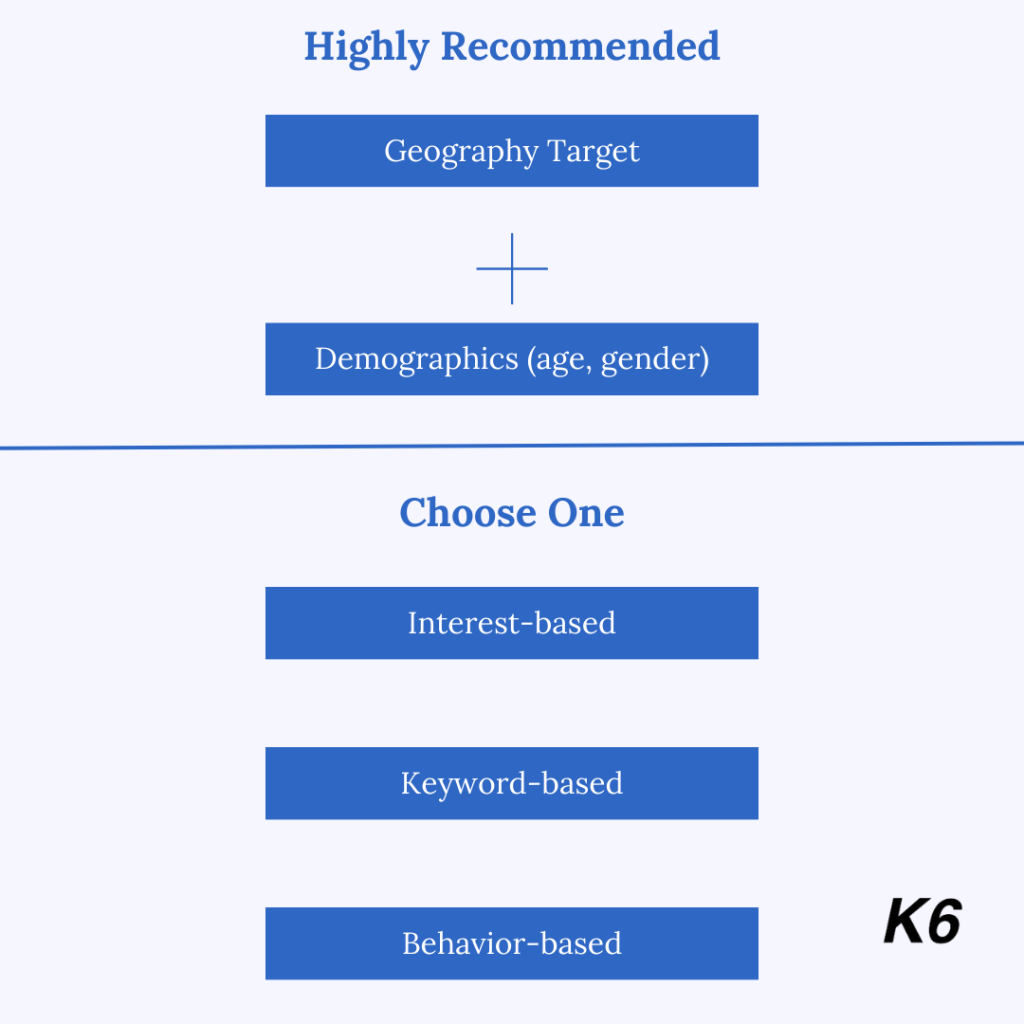
With that in mind, what have we found works best for audience optimization? Personalized audiences, such as custom and lookalike audiences, are always our top choice. Lookalikes take a custom audience—like your past buyers—and find similar people.
If you’re just starting out and don’t have data yet, we highly recommend starting with keyword-based targeting. From there, you can scale up with interest-based and behavior-based targeting, but they’re not our first choice for audience segmentation. As part of our Pinterest ads tips, targeting is crucial.
2. Visual Storytelling
You’ve probably heard it before: marketing is about storytelling. While we often think of stories as complex plots filled with mystery and suspense, that’s not the case here. In Pinterest ads, storytelling is simply about sharing the narrative you want your customers to tell themselves.
For example, a men’s sneaker brand could use a still image of a guy casually walking through New York City. The focus is on the story you want your customers to imagine for themselves. After all, we’re in marketing, not Hollywood.
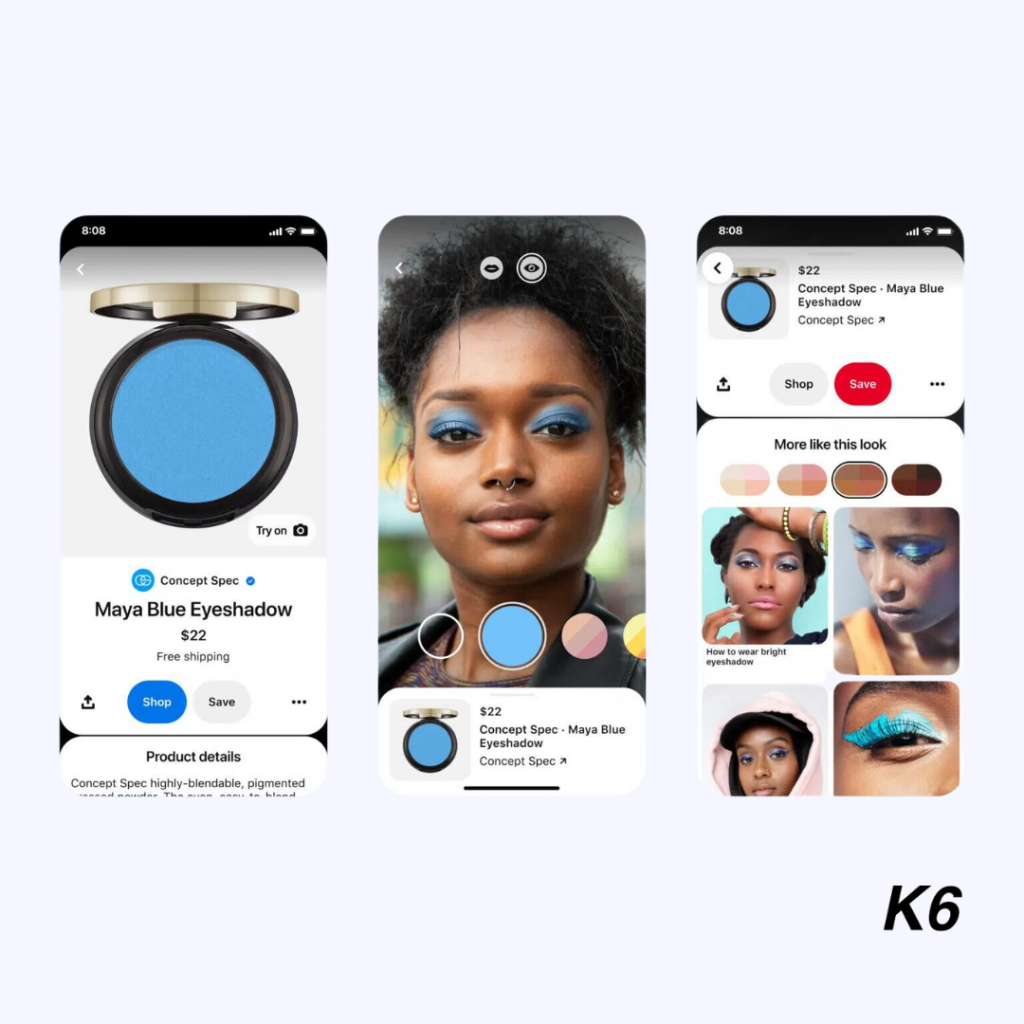
As you can see, this part varies for each brand on Pinterest and is influenced by consumer psychology. Be sure to use high-resolution images and start with at least 3-5 different pins. Anything fewer than that likely won’t perform well. If you’ve heard of A/B testing, now’s the time to put it into practice.
3. Video Pins
Have you ever come across a video on Pinterest? I have, and honestly, it’s the only thing that grabs my attention. Most of Pinterest is filled with static, sleek images of recipes, sneakers, or whatever else piques your interest. But when a video ad pops up, it really stands out.
The downside (yes, there is one) is that people have higher expectations for videos on Pinterest. Why? Because the images are so polished that your video needs to compete with them. Plus, we all know that creating a stunning image is much easier than producing a great video.
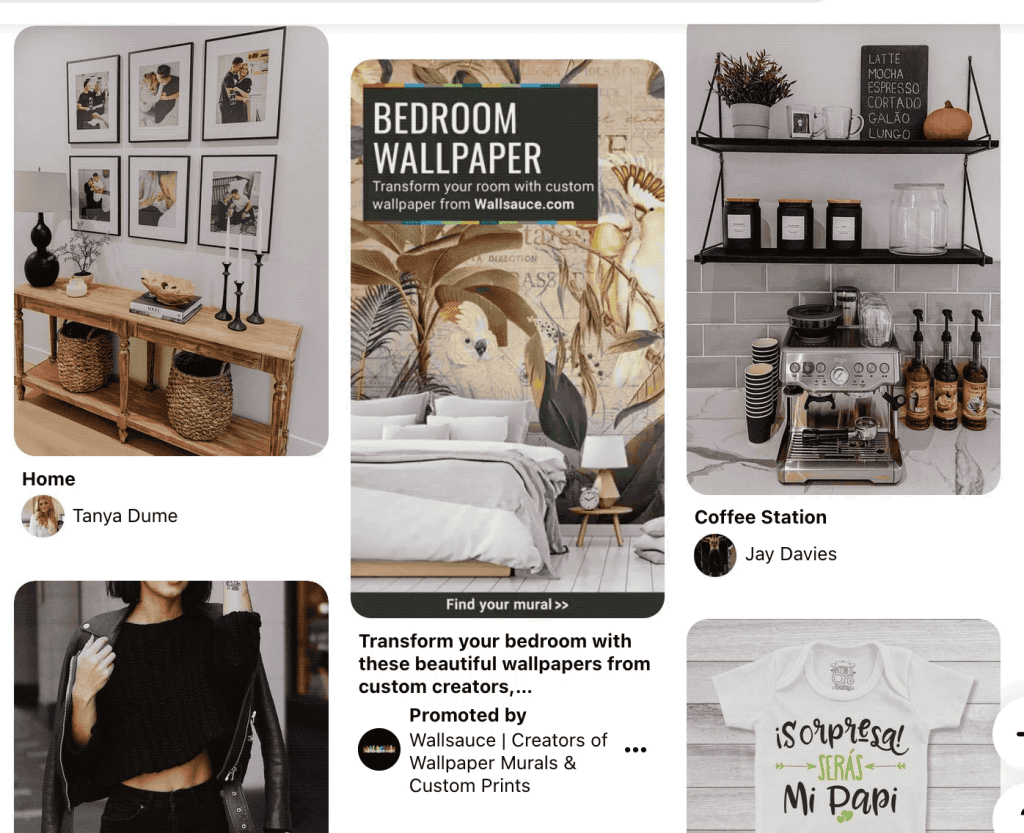
The great thing about Pinterest video ads is that they allow you to demonstrate how your product works while evoking emotions. Consider using an unboxing video, a tutorial, or even a lifestyle shot to connect with your audience. A helpful tip is to envision your ideal customer and tailor the video to them.
To create a high-performing Pinterest ad, you need to convince people of just one thing—and only one. For example, highlight the fact that your product cleans windows exceptionally well. Since people tend to focus on the most compelling benefit, it’s best to showcase your strongest one to drive conversions.
4. Keyword Optimization
Conducting thorough keyword research is crucial for improving your Pinterest ad results. It helps optimize your Pin descriptions and titles, making them more searchable and discoverable. Start by identifying keywords that resonate with your target audience, then align those keywords with the content of your Pins.
Effective keyword research begins by understanding the interests, preferences, and intentions of your target market. From there, you can uncover trending terms, related phrases, and long-tail keywords that are frequently used, ensuring your Pins reach the right people at the right time.
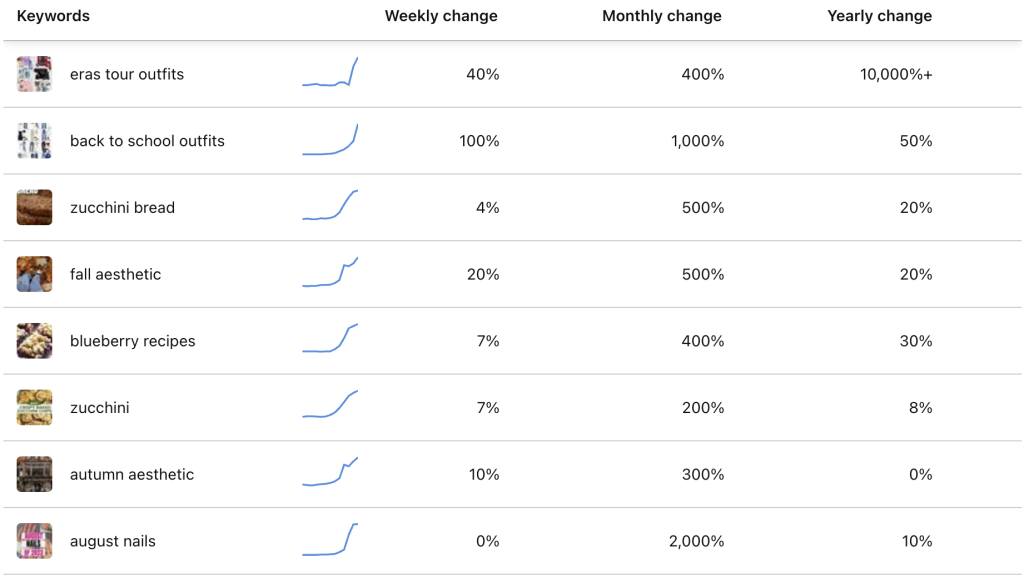
You need to put yourself in the customer’s shoes. They typically search for specific items, like “beige sweater inspiration.” By using specific, relevant keywords, you increase your chances of showing up when someone is looking exactly for your product. But here’s the key: your keywords must be coherent. Don’t just add random terms. This is a crucial part of optimizing your Pinterest ads.
5. Rich Pins
Implementing Rich Pins is a powerful strategy for Pinterest ads. These Pins include additional information such as product details, prices, and availability, providing a dynamic way to present essential information directly within the Pin. Rich Pins offer users a seamless experience, allowing them to access key details without needing to navigate away from the platform.
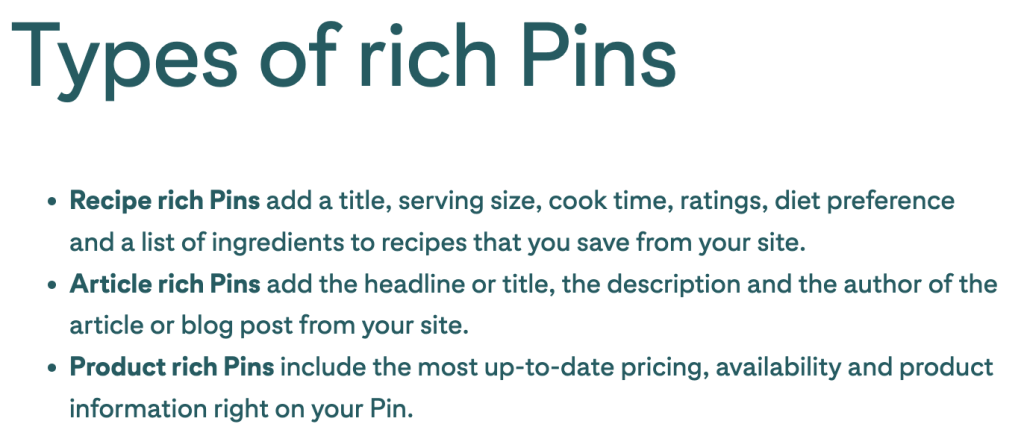
For e-commerce brands, Rich Pins can be incredibly powerful as they automatically update product information and pricing. This makes management easier while showcasing a wide range of products in your inventory. While they don’t always guarantee success, they’re still a great starting point for your Pinterest ads strategy.
6. Shopping Ads
By utilizing Shopping Ads, you can display product information and prices directly on the Pin. Integrating key product details within the Pin itself leads to higher-quality clicks, as users know exactly what they’re getting. The major advantage is that it eliminates the need for users to click through multiple pages to access crucial information, streamlining their buying process.
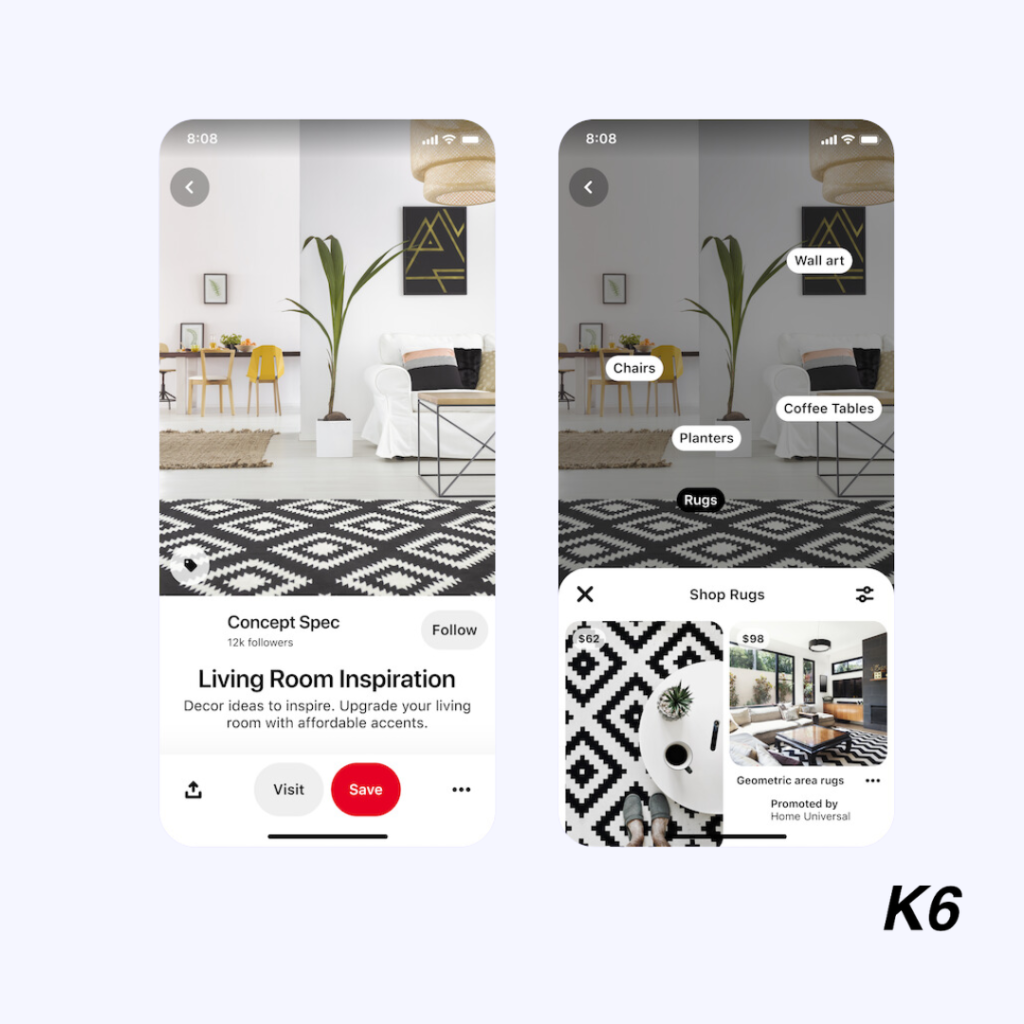
The visual nature of Pinterest aligns perfectly with this strategy, allowing users to instantly visualize how the product fits into their lifestyle or aspirations. Additionally, Shopping Ads with embedded product information make Pins more appealing and relevant, boosting engagement and conversions. In my experience, the simpler the purchasing flow, the better your Pinterest ads will perform. The only downside is that Shopping Ads offer less creative control compared to other formats.
7. Promoted Pins
You can boost visibility by promoting your most valuable Pins to a larger audience. This approach allows you to leverage your most popular Pins and target your ideal audience with your end goal in mind. However, the downside is that while popular Pins may drive more engagement and clicks, they don’t always result in conversions. On Pinterest, achieving conversions often requires a more tailored approach than just boosting well-performing content.
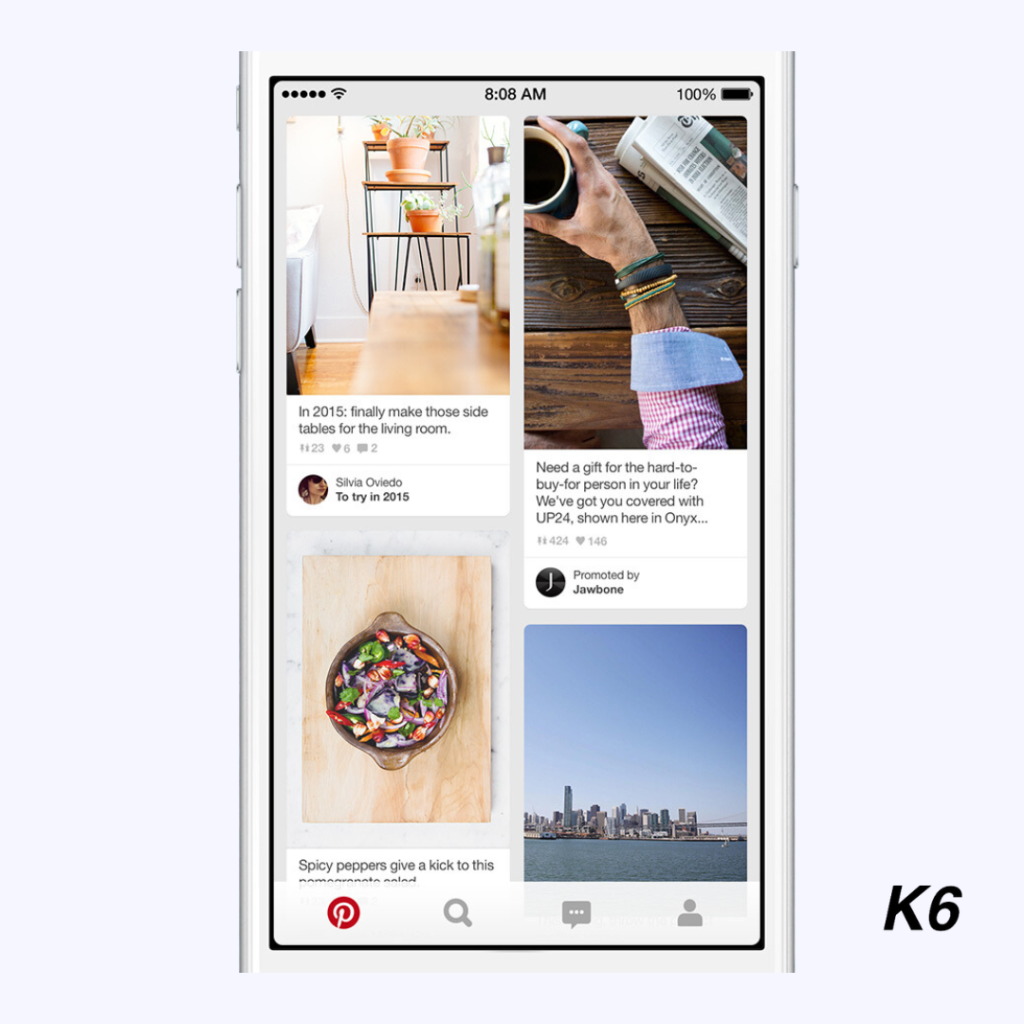
What you can control in this type of Pinterest ads campaign is your targeting. I highly recommend taking the time to explore your options, such as interests, behaviors, demographics, custom audiences, or even lookalike audiences. Keep in mind that while this strategy is effective for boosting engagement, it often falls short when it comes to driving conversions.
8. Retargeting
You can rekindle connections with users who have engaged with your brand in the past. While retargeting campaigns have lost popularity, they are still important. Retargeting leverages the principle of familiarity, where users are more likely to engage with content from brands they recognize.
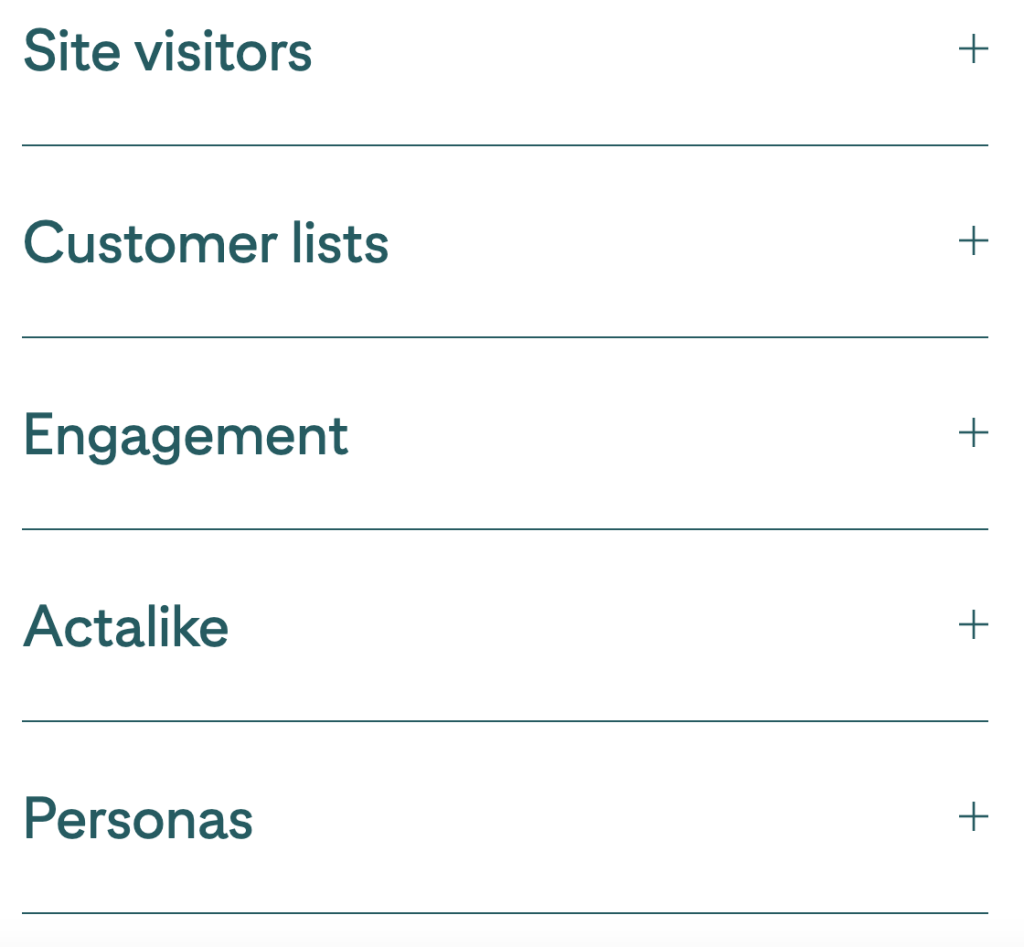
Through tailored ad placements, you can remind these users of their initial interest, enticing them to revisit your brand’s offerings. This not only reinforces brand visibility but also nurtures a sense of personalized engagement. The end result is a stronger bond between the user and your brand.
Moreover, Pinterest ads provide a potent strategy for driving conversions by capitalizing on users’ prior interactions with products. The platform’s visual nature aligns well with showcasing products, making it an ideal space to remind users of items they had previously expressed interest in. By displaying these products within the ads, you can trigger a sense of urgency or desire. In turn, it prompts users to take the desired action, whether it’s making a purchase, signing up for a service, or exploring more.
9. Seasonal Campaigns
Creating timely and relevant campaigns within the scope of Pinterest ads can significantly enhance your brand’s visibility and engagement. By aligning your campaigns with holidays, seasons, and emerging trends, you can tap into the innate consumer interest that surrounds these occasions. Whether it’s Valentine’s Day, Back-to-School season, or a trending health and wellness concept, tailoring your ads to these themes enables you to directly address users’ current interests and needs.
This relevance not only captures their attention but also boosts the likelihood of users engaging with and sharing your content organically. An adaptable and dynamic approach to Pinterest ads ensures that you remain connected with your audience’s evolving preferences, nurturing a sense of brand awareness that resonates beyond individual campaigns.
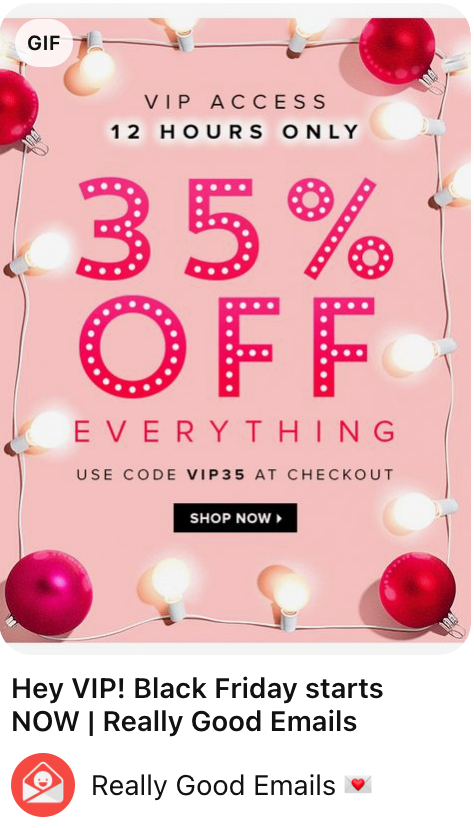
By infusing your ads with holiday-related imagery, colors, and messaging that evoke feelings of nostalgia, excitement, and community, you can leverage this emotional resonance. Doing so helps you establish a deeper bond with your audience and position your products or services as integral components of their celebrations. Pinterest’s visually rich platform provides a canvas for you to showcase your creative prowess, enabling brands to craft ads that capture the festive spirit and leave a lasting impact on users. This translates into higher engagement, conversion rates, and increased brand loyalty.
10. Collaborations and Influencers
Harnessing the influence of content creators and influencers can revolutionize your strategy within the realm of Pinterest ads. Collaborating with these individuals enables you to tap into well-established audiences that hold trust and resonance with the influencer’s content. This partnership not only magnifies the reach of your Pinterest campaigns but also bolsters your brand’s credibility through association.
Influencers infuse authenticity and a personalized touch into the content, making it highly relatable to their followers. By aligning your brand’s values and messaging with those of the influencer, you can create a seamless fusion that exudes authenticity rather than overt promotion. This not only introduces your brand to new audiences but also nurtures a sense of community and engagement around your offerings.
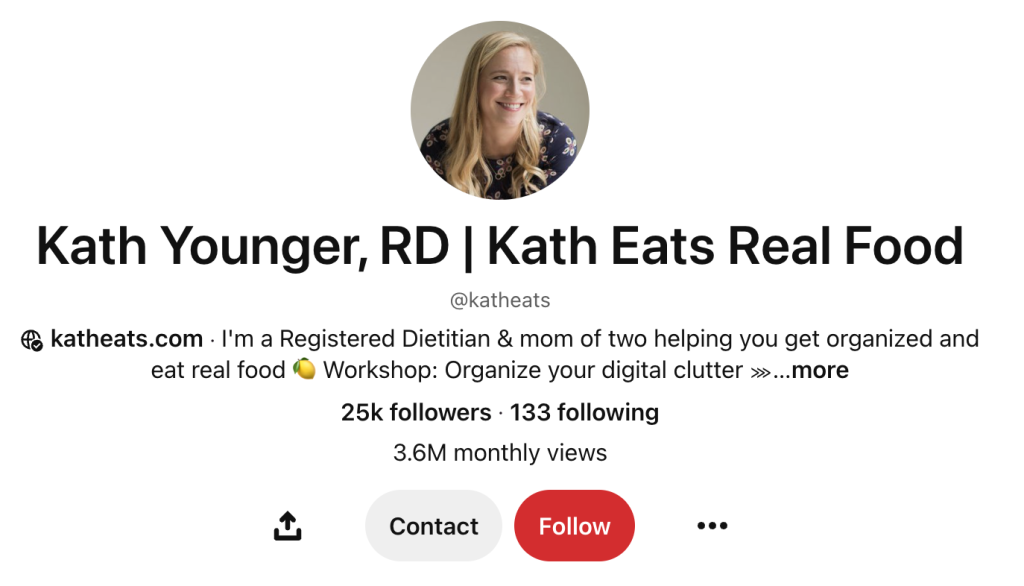
Through collaborative content creation that harmonizes with the influencer’s voice and your brand’s objectives, you can cultivate a profound connection with the audience. This connection transcends traditional advertising, resonating as a recommendation from a trusted source. As influencers and creators share their perspectives and experiences with their followers, the authenticity of the content can drive heightened engagement, conversion rates, and enduring loyalty. Users tend to heed the recommendations of figures they trust, establishing a stronger foundation for long-term relationships.
11. User-Generated Content
Customizing your Pinterest ad campaigns to specific geographic regions and languages is a strategic way to connect with diverse audiences. Recognizing variations in consumer preferences, cultural nuances, and languages among different regions, this tactic enables you to align your messaging with local sensibilities.
Tailoring campaigns to different locations allows you to spotlight products, services, and content that resonate with your target audience, showcasing an understanding of the local market. This boosts your chances of capturing user attention and driving engagement. Adapting campaigns to various languages enhances accessibility, ensuring clear communication and eliminating language barriers, facilitating meaningful connections with users worldwide.
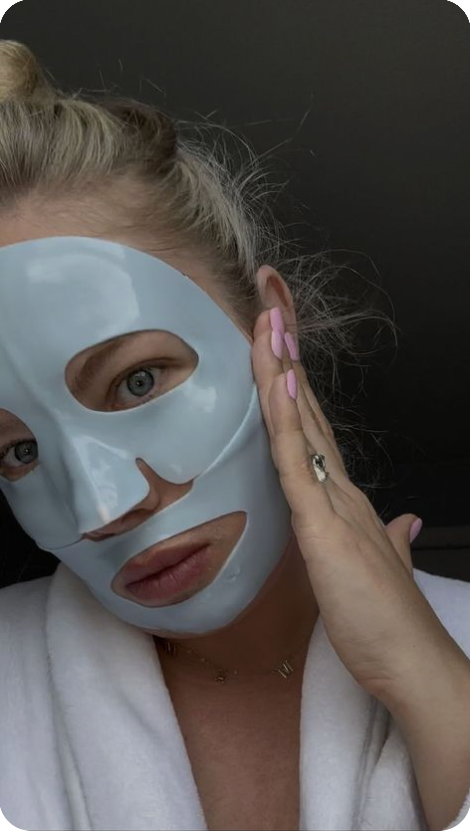
Different cultures hold distinct values, traditions, and interests. By incorporating content that resonates with these aspects—be it culturally significant visuals, references to local events, or using native language—you foster relatability and inclusivity. This strategy can lead to heightened brand loyalty, stronger customer relationships, and overall improved performance of your Pinterest ad campaigns across diverse markets as part of our Pinterest ads tips.
12. Localized Targeting
Customizing your Pinterest ad campaigns to specific geographic regions and languages is a savvy strategy to resonate with your diverse audience. Recognizing the variations in consumer preferences, cultural nuances, and languages across different regions, this approach allows you to align your messaging with local sensibilities. By tailoring campaigns based on location, you can showcase products, services, and content that are particularly relevant to your target audience.
This not only demonstrates your understanding of the local market but also increases the likelihood of capturing user attention and driving engagement. Adapting campaigns to different languages enhances accessibility, ensuring clear and effective communication, eliminating language barriers, and facilitating meaningful connections with users from around the world.
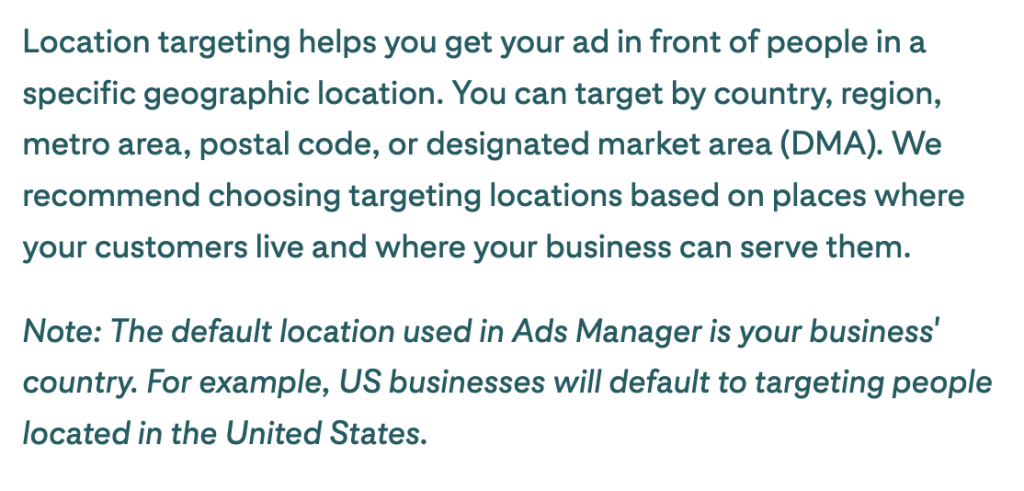
Furthermore, using localized content and messaging within your Pinterest ads strengthens the connection between you and your diverse audience. Different cultures have unique values, traditions, and interests. By incorporating content that resonates with these aspects—whether it’s culturally significant visuals, references to local events, or using language that feels native—you foster a sense of relatability and inclusivity.
This personalized touch not only increases the chances of users engaging with your ad but also communicates your dedication to building relationships and understanding the diverse backgrounds of your customers. This approach can lead to heightened brand loyalty, stronger customer relationships, and an overall improved performance of your Pinterest ad campaigns across a range of markets.
13. Mobile Optimization
In Pinterest ads, your Pins must not only look good but also be optimized for mobile devices. As most users access Pinterest via mobile, create Pins that offer a seamless experience on smaller screens. Use impactful visuals, readable fonts, and clear messaging for easy viewing. This ensures smooth exploration and interaction, boosting engagement and conversions.

Since the majority of Pinterest users access the platform via mobile, tailor your ad strategies accordingly. With mobile usage on the rise, adapt your content. Design Pins with mobile users in mind—use vertical orientation, tappable buttons, and swipe-friendly formats. By catering to mobile preferences, your Pinterest ads become effective, memorable, and enhance your brand’s presence in the mobile Pinterest landscape.
14. Interactive Pins
Experimenting with interactive Pins, such as polls, quizzes, and shoppable Pins, opens up a world of creative possibilities to enhance engagement and elevate the dynamic nature of your Pinterest ads. These interactive formats not only capture users’ attention but also encourage them to actively participate and explore your content.

In other words, you will create an interactive dialogue with your audience, inviting them to express their opinions or test their knowledge. This two-way communication fosters a sense of connection and involvement, making users more likely to spend time with your content and remember your brand.
Additionally, shoppable Pins enable users to seamlessly transition from inspiration to action by allowing them to directly purchase products featured in your Pin. This frictionless experience transforms the visual inspiration into tangible results, driving conversions and making the path to purchase more intuitive as part of our Pinterest ads tips.
15. A/B Testing
Continuously testing different ad elements, including visuals, copy, and calls to action (CTAs), is the foundation of Pinterest ads and enhancing your results. By running A/B tests, you can gain valuable insights into what resonates most with your target audience (and it will surprise you).
Visuals play a pivotal role in capturing attention, so testing different imagery or video styles can help identify which visuals generate higher engagement and click-through rates. Additionally, experimenting with copy variations and CTAs allows you to refine your messaging to better connect with users’ preferences and motivations. This iterative testing process empowers you to make data-driven decisions, because we’re often wrong about what our customers want.
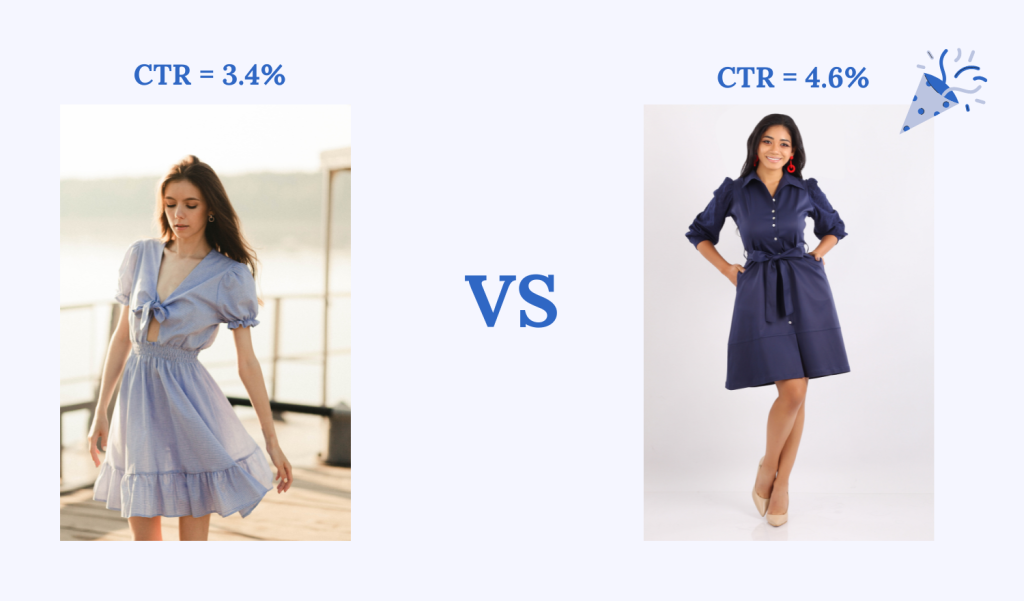
To make this strategy work, you must have a solid Pinterest ads A/B test analysis process. I recommend creating a monthly routine of analyzing and sharing the insights of A/B testing results with anyone involved with the Pinterest ads. This will create what I call a collective brain to continuously improve your results overtime and truly drive the Pinterest ads performance you deserve as part of our Pinterest ads tips.
16. Pinterest Trends
Staying updated on Pinterest trends and integrating them into your ad strategy is a key strategy to maintaining relevance and maximizing the impact of your advertising efforts. Pinterest is a platform known for its ever-evolving user interests and preferences, so keeping a finger on the pulse of emerging trends allows you to align your content with what’s currently popular. By closely monitoring trending topics, design styles, and user behaviors, you can ensure that your ad campaigns reflect the latest interests and capture users’ attention. In other words, stay proactive and don’t show the content of last year to have high performing Pinterest ads campaign.
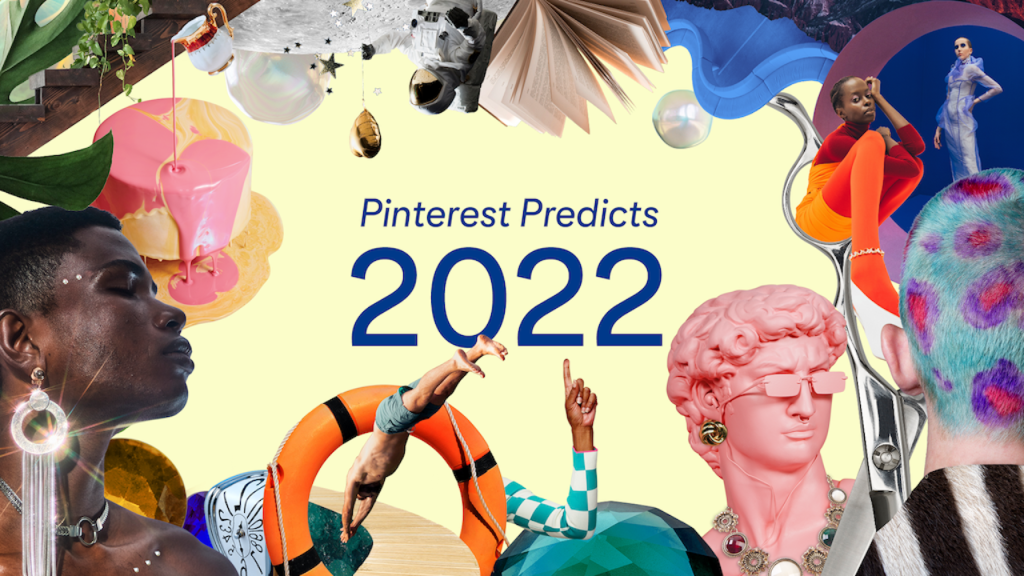
You can also incorporate keywords related to trending topics within your ad campaigns increases the likelihood of your content appearing in search results and category feeds. This allows you to tap into conversations and interests that are top-of-mind for users, enabling your brand to be part of current discussions. By integrating these keywords strategically into your ad copy and descriptions, you demonstrate your brand’s relevance and understanding of user preferences as part of our Pinterest ads tips.
17. Conversion Tracking
First, establishing accurate conversion tracking mechanisms is a foundational step in gauging the effectiveness of your campaigns on Pinterest. By implementing robust tracking tools, you gain valuable insights into the actions users take after interacting with your ads. This includes tracking website visits, sign-ups, purchases, and other meaningful conversions.
Proper conversion tracking allows you to attribute specific outcomes to your ad campaigns, enabling you to quantify the return on your investment accurately. This data-driven approach empowers you to make informed decisions about which strategies are generating the best results, and allocate resources effectively to optimize your future campaigns.
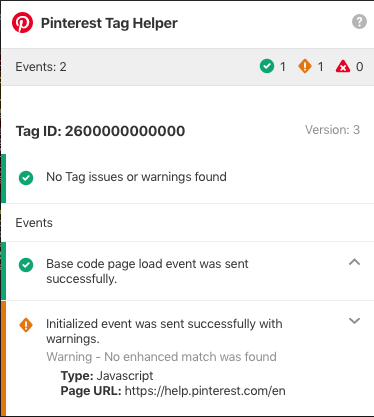
Second, analyzing the collected data is a crucial phase in the campaign management process, as it empowers you to fine-tune your targeting and enhance your return on investment (ROI). By delving into performance metrics such as click-through rates, conversion rates, and cost-per-conversion, you can gain a comprehensive understanding of what’s working and what requires adjustments.
Careful analysis of the data helps you identify trends, patterns, and areas for improvement within your campaigns. You can pinpoint which audience segments are responding positively to your content, which keywords are driving the most conversions, and which ad formats are delivering the highest engagement.
Armed with this knowledge, you can optimize your targeting strategy, tailor your messaging, and allocate your budget more effectively. Data-driven refinements enable you to continuously enhance your campaigns, increase your ROI, and ensure that your Pinterest advertising efforts are aligned with your overarching marketing goals as part of our Pinterest ads tips.
18. Custom Audiences
Crafting custom audiences derived from website visitors, email lists, or app users is a very good way to personalize your Pinterest ad campaigns. These custom audiences allow you to segment your potential audience based on their previous interactions with your brand. For instance, you can build a website visitor audience, email subscribers, or app downloaders.
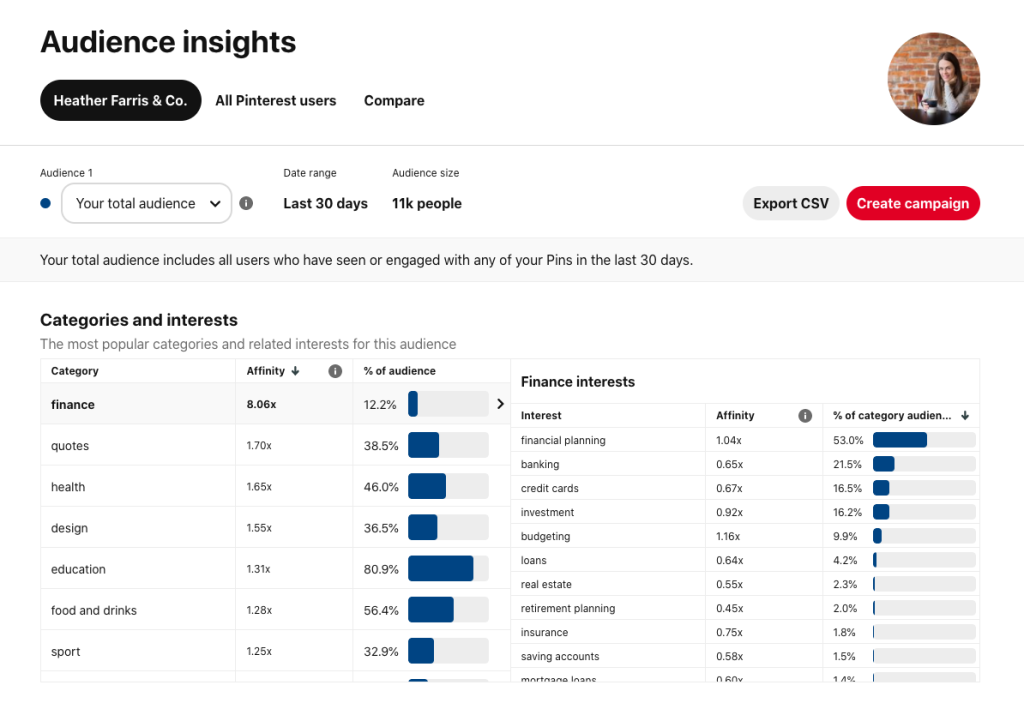
The end goal is to deliver tailored content that speaks directly to their preferences. As you’ve guessed it, the goal is to nurture the already existing relationship. While this strategy can be highly profitable for Pinterest ads, I would recommend you treat it as a way to deepen your bond with customers and not milk as much money as possible from their wallet. You will benefit in the long term much more from this approach than a transactional focused approach as part of our Pinterest ads tips.
19. Story Pins
Leveraging Story Pins will help you craft an immersive and engaging narratives to enhance your Pinterest ad results. They also offer a dynamic format allowing you to go beyond traditional static content, creating visually captivating sequences. This format is particularly effective for showcasing step-by-step tutorials, how-to guides, and brand stories.
Through a series of images, videos, and text, you can guide users through various stages of a process, providing them with valuable information and inspiration in a visually appealing manner. Users can swipe through each slide, making them more likely to spend time engaging with your content and developing a deeper connection to your brand.
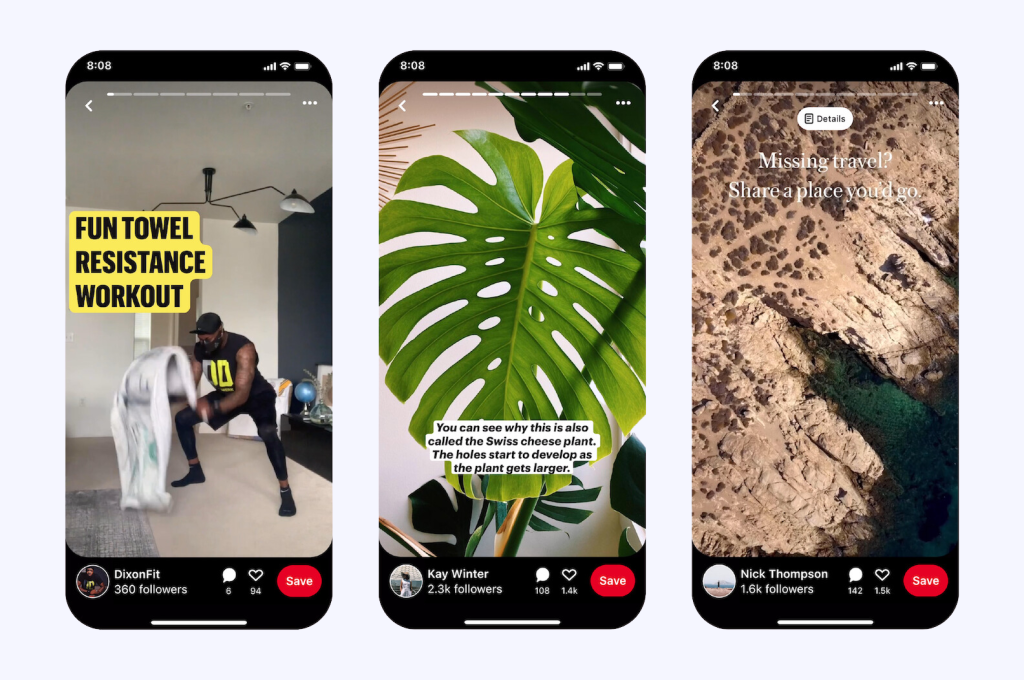
You can even incorporate behind-the-scenes glimpses, testimonials, and anecdotes. This authenticity resonates with users and can foster a sense of connection and trust. We haven’t generated massive sales from this type of campaign but these ads work really well for retargeting. The main reason is they allow your audience to be entertained in a new way as part of our Pinterest ads tips.
20. Landing Page Optimization
Ensuring consistency between your Pin and landing page is a critical strategy for delivering a seamless user experience and driving higher conversion rates. When users click on your Pin, they expect to be seamlessly transitioned to a landing page that aligns with the content and promises made in the Pin itself (it’s common sense but often forgotten).
A disjointed experience, where the landing page fails to deliver on the expectations set by the Pin, can lead to user frustration and abandonment. By maintaining a coherent visual and messaging alignment between your Pin and landing page, you provide a consistent and reassuring experience that keeps users engaged and encourages them to take your desired action.
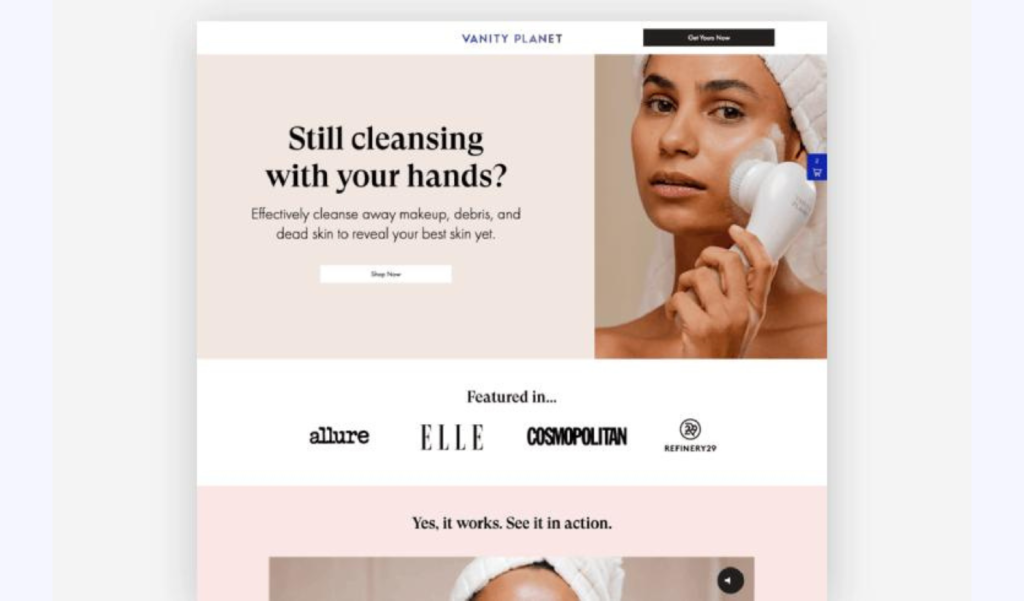
On top of that, optimizing landing pages for faster loading times and mobile responsiveness is crucial to maximizing conversions. Users on Pinterest often engage with Pins on various devices, including smartphones and tablets. If your landing page doesn’t load quickly or isn’t properly responsive to different screen sizes, users might bounce off. A seamless transition from Pin to landing page ensures that users can smoothly continue their journey, allowing your Pinterest ad campaigns to deliver their intended results effectively.
21. Ad Budget Management
Establishing realistic budgets and bid strategies aligned with your campaign goals is a fundamental aspect of Pinterest ads. Before launching a campaign, you have to know your goal, whether it’s about brand awareness, website visits, or conversions. With a clear goal, you can focus your budget on what your intended outcome is and ensure you’re investing your money to reach your goal. I recommend setting achievable budgets and bid strategies to get exactly what you’re looking for.
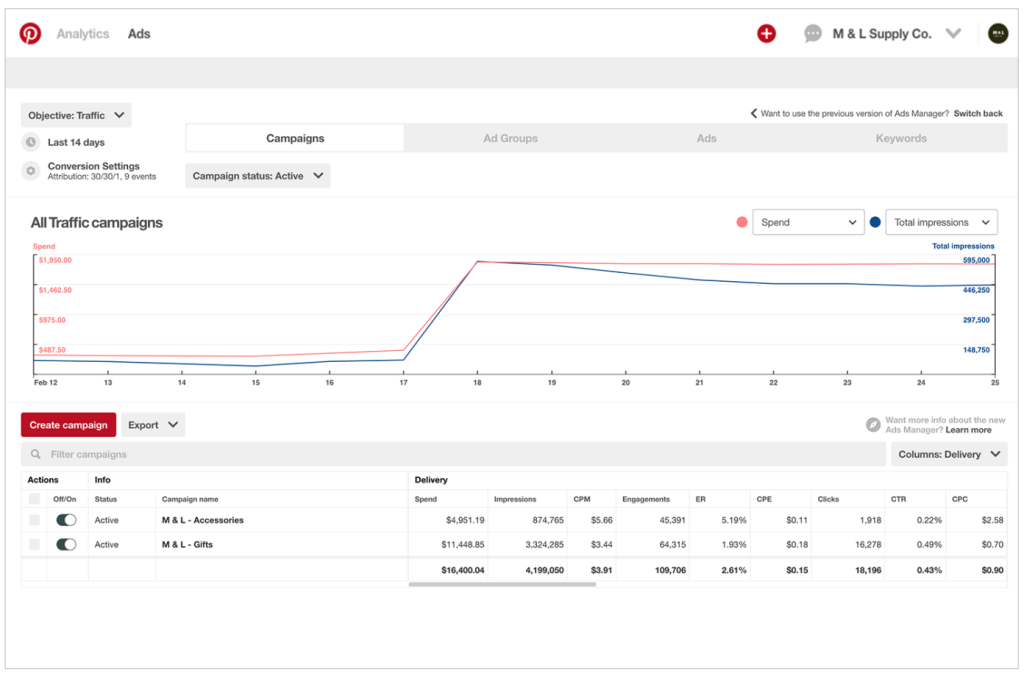
It doesn’t end there, you must continuously monitor ad spend and adjust strategies based on performance data. This part is dynamic and making sure your campaigns remain effective and efficient is key. As your ads run, gather insights from key performance metrics such as click-through rates, conversion rates, and return on ad spend.
This data provides valuable feedback on the effectiveness of your Pinterest ads campaign and allows you to identify areas for improvement. For instance, if you’re over performing, you might consider adding even more budget. On the other hand, if certain campaigns are underperforming, adjustments can be made to optimize their outcomes. I highly recommend you stay on top of ad spend.
Want more Pinterest ads tips?
Three significant trends are sure to shape the landscape of Pinterest advertising in the coming years. Firstly, visual content in the form of video Pins will make a huge dent. Businesses that invest in compelling video & story Pins can capture the attention of Pinterest’s visually-oriented user base.
Secondly, Pinterest’s commitment to e-commerce integration is expected to continue expanding. Enhanced shopping experiences, augmented reality try-ons, and simplified checkout processes are anticipated to become integral parts of Pinterest ads. Thirdly, artificial intelligence (AI) to refine content recommendations will extend to advertising. The end goal is to improve data-backed decisions, audience targeting and creative optimization.
The future is full of bright colors for Pinterest and hopefully you’ll be part of the boat. I think brands are often afraid of change but this one can be very beneficial. Just think about it – improved optimization, better eCommerce experience and compelling videos.

